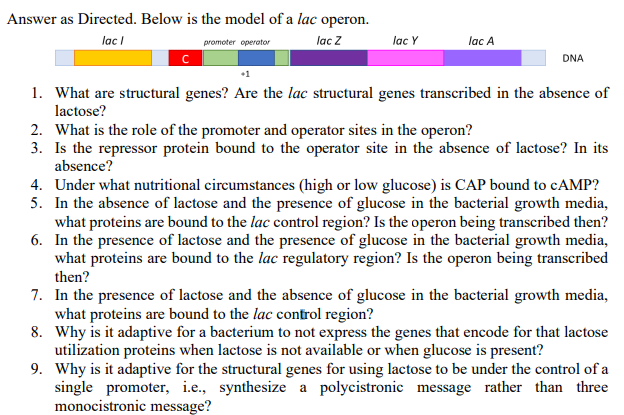8. Why is it adaptive for a bacterium to not express the genes that encode for that lactose utilization proteins when lactose is not available or when glucose is present? 9. Why is it adaptive for the structural genes for using lactose to be under the control of a single promoter, i.e., synthesize a polycistronic message rather than three monocistronic message?
8. Why is it adaptive for a bacterium to not express the genes that encode for that lactose utilization proteins when lactose is not available or when glucose is present? 9. Why is it adaptive for the structural genes for using lactose to be under the control of a single promoter, i.e., synthesize a polycistronic message rather than three monocistronic message?
Biology: The Dynamic Science (MindTap Course List)
4th Edition
ISBN:9781305389892
Author:Peter J. Russell, Paul E. Hertz, Beverly McMillan
Publisher:Peter J. Russell, Paul E. Hertz, Beverly McMillan
Chapter16: Regulation Of Gene Expression
Section: Chapter Questions
Problem 2TYK: For the E. coli lac operon, when lactose is present: a. and glucose is absent, cAMP binds and...
Related questions
Question
Please answer item number 8 and 9.

Transcribed Image Text:Answer as Directed. Below is the model of a lac operon.
lac Z
lac I
promoter operator
с
lac Y
lac A
DNA
1. What are structural genes? Are the lac structural genes transcribed in the absence of
lactose?
2. What is the role of the promoter and operator sites in the operon?
3. Is the repressor protein bound to the operator site in the absence of lactose? In its
absence?
4. Under what nutritional circumstances (high or low glucose) is CAP bound to cAMP?
5. In the absence of lactose and the presence of glucose in the bacterial growth media,
what proteins are bound to the lac control region? Is the operon being transcribed then?
6. In the presence of lactose and the presence of glucose in the bacterial growth media,
what proteins are bound to the lac regulatory region? Is the operon being transcribed
then?
7. In the presence of lactose and the absence of glucose in the bacterial growth media,
what proteins are bound to the lac control region?
8. Why is it adaptive for a bacterium to not express the genes that encode for that lactose
utilization proteins when lactose is not available or when glucose is present?
9. Why is it adaptive for the structural genes for using lactose to be under the control of a
single promoter, i.e., synthesize a polycistronic message rather than three
monocistronic message?
Expert Solution
This question has been solved!
Explore an expertly crafted, step-by-step solution for a thorough understanding of key concepts.
Step by step
Solved in 2 steps

Knowledge Booster
Learn more about
Need a deep-dive on the concept behind this application? Look no further. Learn more about this topic, biology and related others by exploring similar questions and additional content below.Recommended textbooks for you

Biology: The Dynamic Science (MindTap Course List)
Biology
ISBN:
9781305389892
Author:
Peter J. Russell, Paul E. Hertz, Beverly McMillan
Publisher:
Cengage Learning

Biology (MindTap Course List)
Biology
ISBN:
9781337392938
Author:
Eldra Solomon, Charles Martin, Diana W. Martin, Linda R. Berg
Publisher:
Cengage Learning

Biology 2e
Biology
ISBN:
9781947172517
Author:
Matthew Douglas, Jung Choi, Mary Ann Clark
Publisher:
OpenStax

Biology: The Dynamic Science (MindTap Course List)
Biology
ISBN:
9781305389892
Author:
Peter J. Russell, Paul E. Hertz, Beverly McMillan
Publisher:
Cengage Learning

Biology (MindTap Course List)
Biology
ISBN:
9781337392938
Author:
Eldra Solomon, Charles Martin, Diana W. Martin, Linda R. Berg
Publisher:
Cengage Learning

Biology 2e
Biology
ISBN:
9781947172517
Author:
Matthew Douglas, Jung Choi, Mary Ann Clark
Publisher:
OpenStax